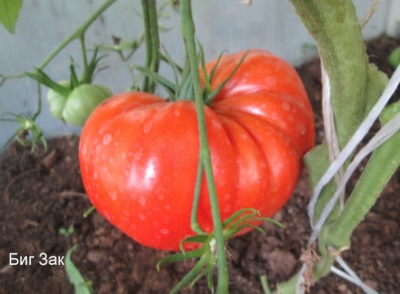
- Authors: Mini Zachariah (New Jersey, USA)
- Name synonyms: Big Zac, Big Zac
- Category: grade
- Growth type: indeterminate
- Appointment: fresh consumption, for juice, for ketchup and tomato paste
- Ripening period: mid-season
- Growing conditions: for greenhouses
- Bush size: tall
- Bush height, cm: up to 200
- Bush characteristic: powerful
Among the large-fruited varieties, there are many giants, but the indeterminate variety Big Zac (synonyms Big Zac, Big Zak), which entered the Guinness Book of Records, strikes with special records. Record-breaking tomatoes gain weight more than 2 or even 3 kg, but the author of the Mini Zakharia variety managed to get a tomato weighing more than 6 kilograms. Giant fruits are intended for fresh consumption and processing into juices, pastes, ketchups. In Russian conditions, the variety is grown in greenhouses.
Breeding history
The giant tomato was bred by an American from New Jersey, USA, Mini Zachariah.
Description of the variety
Big Zak is a powerful bush, 2 meters or more high, with thick stems covered with moderately ruffled leaves of the usual type. The plant requires the formation of a bush of 1-2 stems, constant pinching, rationing of the number of fruits. The more fruits there are on the bush, the smaller they will be. In addition to the obvious advantages, the tomato has some disadvantages.
Advantages | disadvantages |
Great taste | Need for pinning |
High yield | Increased plant care, which includes more frequent feeding |
Record large-fruited | Preventive treatments for diseases and pests are mandatory |
Versatility of appointment | |
The ability to grow not only in a greenhouse, but also outdoors in hot climates |
The plant has an attractive appearance with surprisingly large fruits.
The main qualities of the fruit
Large flat-round, sometimes similar to accreted smaller, fruits have a minimum weight of 500-700 g, but compliance with agrotechnical requirements allows gardeners to get giants weighing more than 2 kilograms. The record holder of last season weighs 3.8 kg. Unripe fruits are colored in a non-uniform green color, changing at the stage of technical ripeness to red.
Taste characteristics
The red pulp of the fruit with white blotches is covered with a thin skin, has a very sweet dessert taste with a slight sour note.
Ripening and fruiting
Bolshoi Zak is a mid-season crop, the harvest begins in late July - early August.
Yield
The tomato is known not only for the large-fruited individual samples, but also for its high yield. One bush is capable of producing up to 30 kilograms of excellent fruits.
The timing of planting seedlings and planting in the ground
Seedlings are planted in the ground at the age of 60-65 days, so they start sowing seeds at the end of February or at the beginning of March.

Growing tomato seedlings is an extremely important process, because it largely depends on whether the gardener will be able to harvest at all. All aspects must be taken into account, from seedbed preparation to planting in the ground.
Landing scheme
When disembarking 1 sq. m it is recommended to place up to three roots.

Growing and care
Growing tomatoes in the open field is possible, but only in the southern regions, therefore, the traditional seedling method is mainly used. Almost everywhere Big Zak is planted and cultivated in greenhouses. It is this approach that allows you to most effectively use the capabilities of the giant tomato. Seedlings are grown in the most usual way, illuminated with phytolamps if the plants are deficient in sunlight. Two weeks before the change of "place of residence" young animals begin to temper, accustom them to the temperature of the external environment, to the bright rays of the sun. They are planted in a greenhouse two months after sowing, in open ground - after the threat of recurrent frosts has passed. If the weather is cold at this time, then young plantings should be covered with agrofibre at night - night frosts can kill plants even in a closed greenhouse. In the open field and in hot weather, seedlings should be shaded for about two weeks.
The cultivar needs fertile, breathable soil. Supports are immediately installed in the prepared holes. The roots of plants are carefully straightened, sprinkled with soil enriched with organic matter and mineral fertilizers, compact the soil, and moisturize well. Further care consists in constant monitoring of the growth of the tomato - this is pinching and the formation of a bush in 2 stems. After the ovaries have appeared on the first flower brush, all the lower leaves are removed. After the next brushes, the leaves are removed through the cutting. The variety needs regular feeding. And also need watering, weeding, loosening and mulching. The giant requires an increased amount of water - in the greenhouse they are watered at least once every 2-3 days.




A plant needs different micronutrients at each stage of growth. All fertilizers can be divided into two groups: mineral and organic. Folk remedies are often used: iodine, yeast, bird droppings, eggshells.
It is important to observe the rate and period of feeding. This also applies to folk remedies and organic fertilizers.
Disease and pest resistance
The powerful plant is characterized by a fairly strong immunity to diseases and pest attacks characteristic of nightshade. However, preventive treatments with insecticides and fungicides are required in order not to lose an excellent promising crop.


Resistant to adverse weather conditions
In this regard, the variety cannot boast of outstanding characteristics - it does not tolerate temperature drops, sharp cold snaps, and does not tolerate even minimal frosts at all.
Growing regions
Since the homeland of tomato is on the American continent, it is very common in America, Canada and Europe. In our country, it is grown in Ukraine, Belarus, Central Black Earth Region, as well as in greenhouses in almost all regions.

























































































